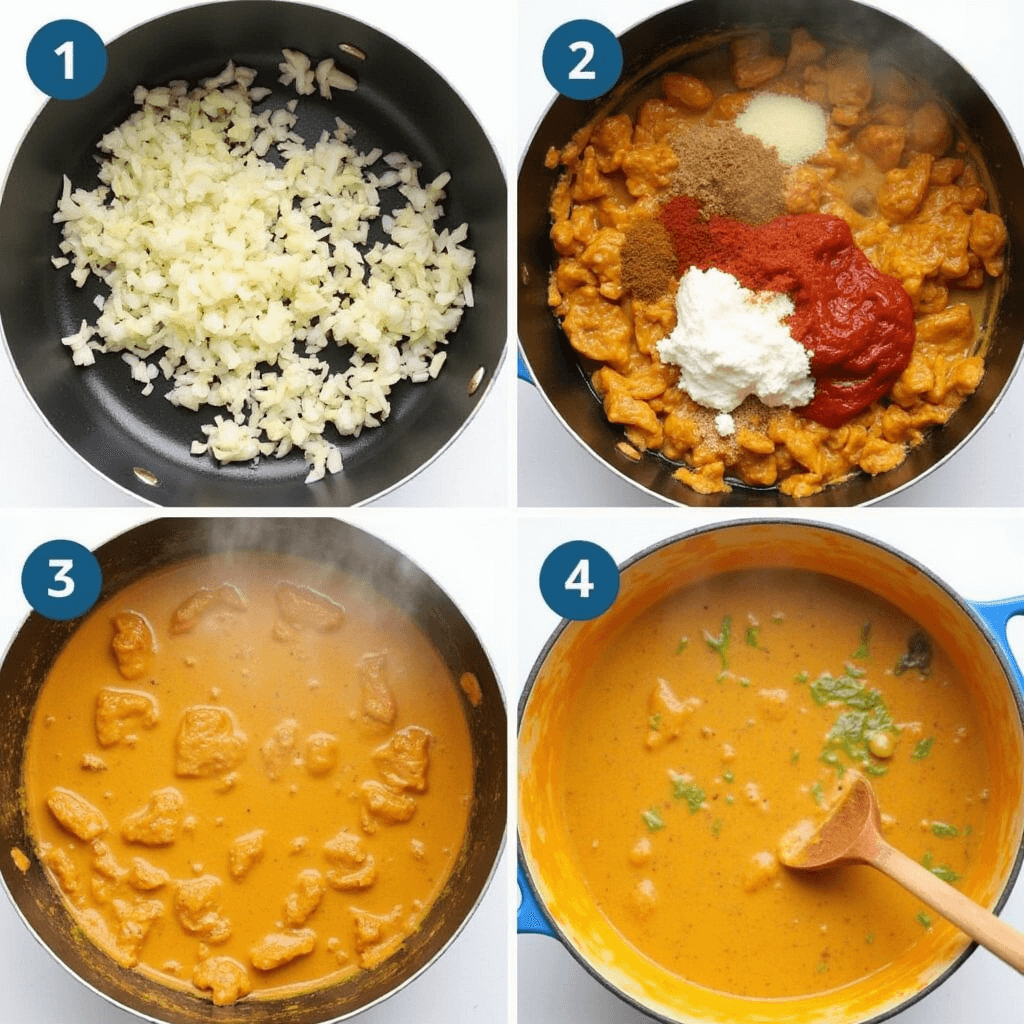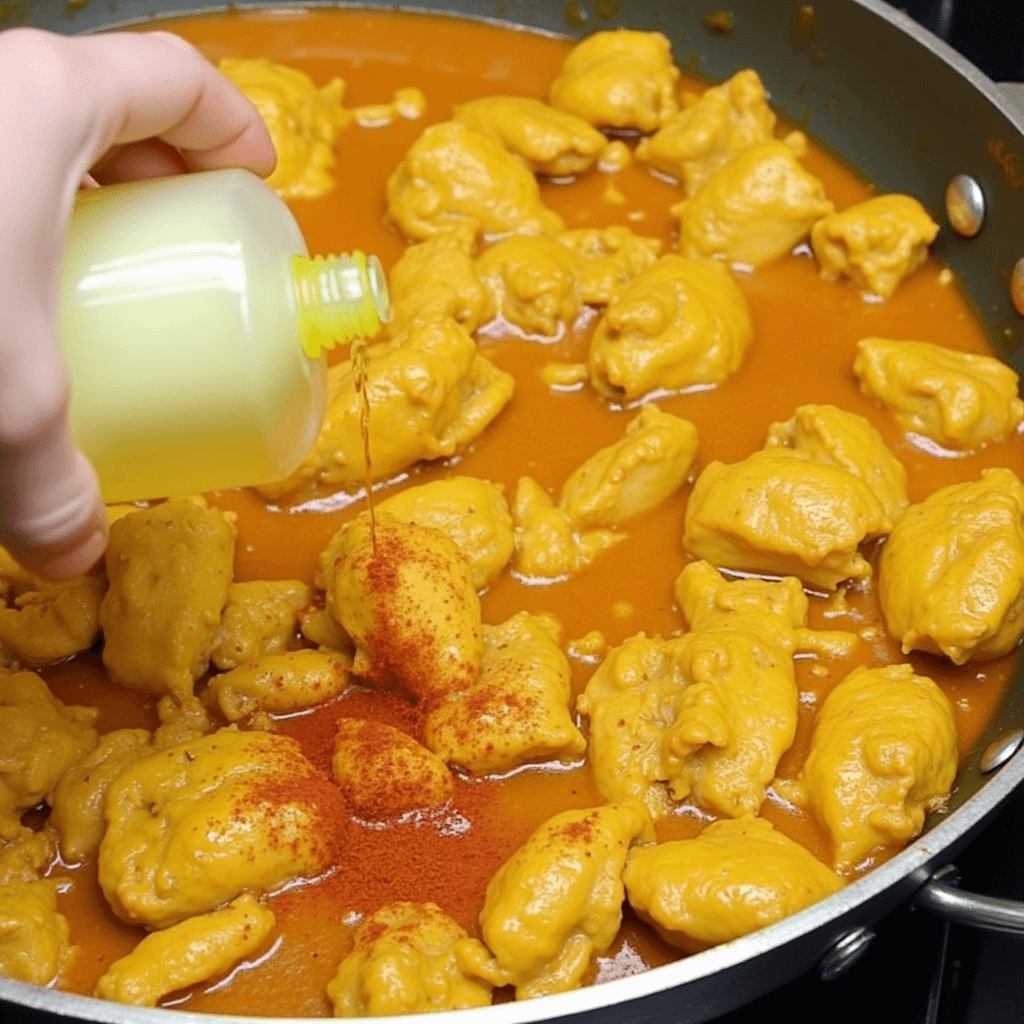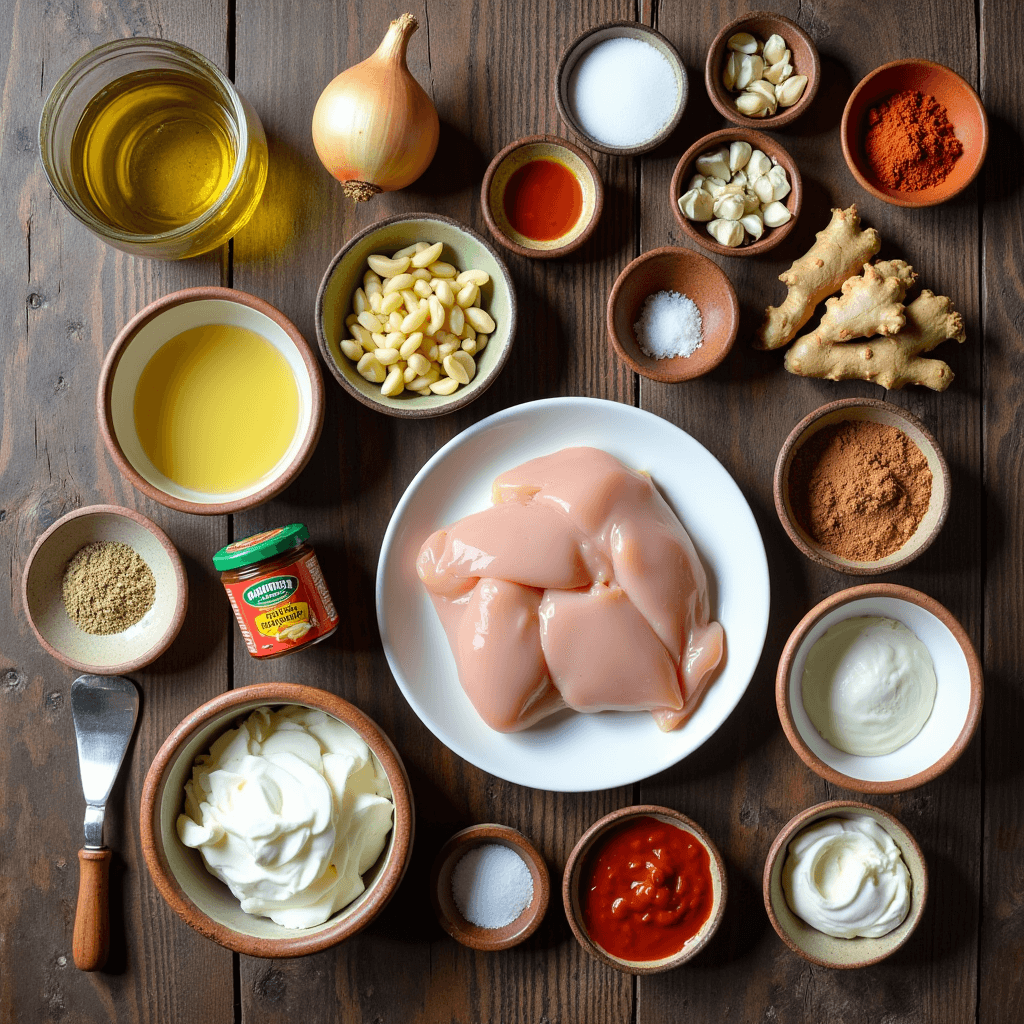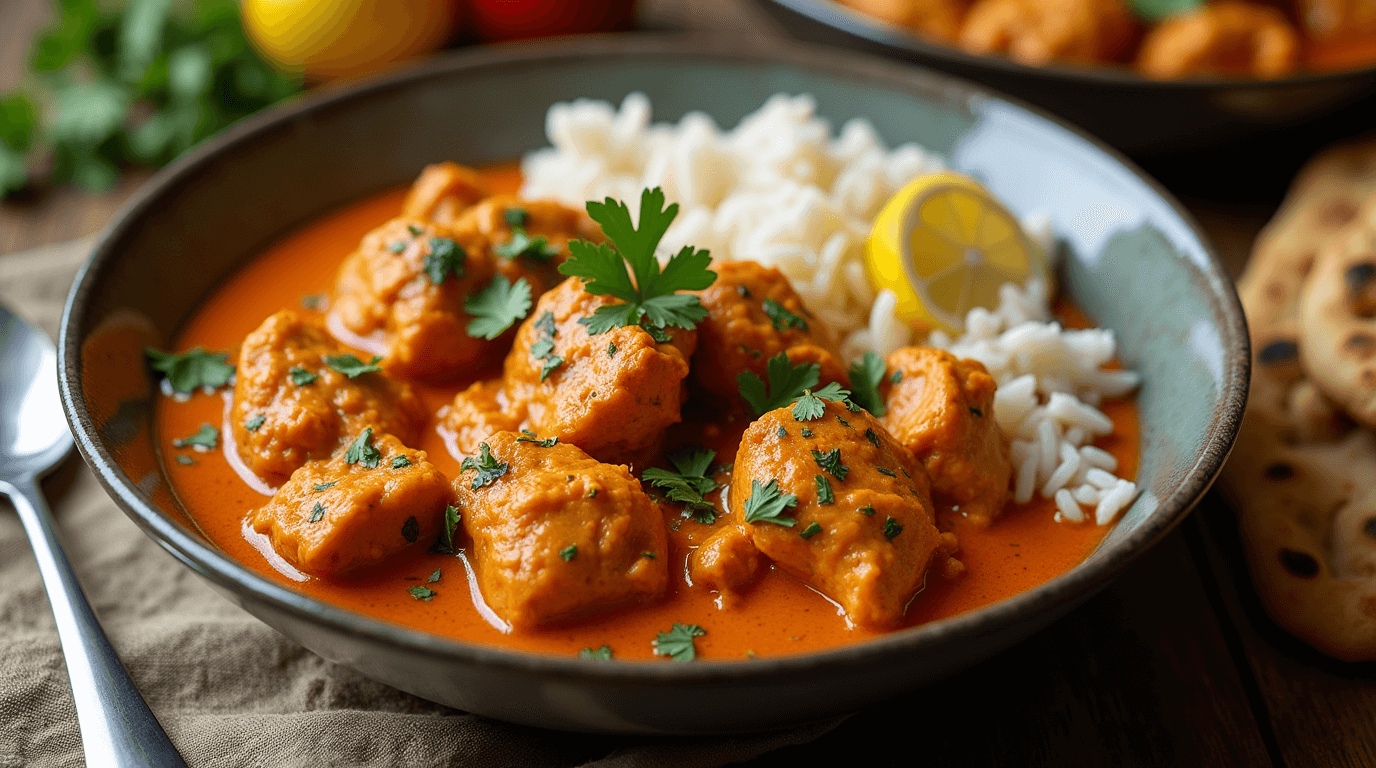Indian Chicken Curry Recipe Overview
Table of Contents
Introduction
This chicken curry recipe brings the rich flavors of Indian cuisine into your kitchen with a creamy, aromatic dish that’s quick to prepare. The dish combines tender pieces of chicken simmered in a savory tomato-based sauce, enriched with a blend of traditional spices. In under an hour, you can enjoy a restaurant-quality meal, complete with a balance of heat, depth, and creaminess. Whether it’s a busy weeknight or a special dinner, this curry will captivate your taste buds with its vibrant flavors, making it a perfect choice for both beginners and seasoned cooks alike.
What is Indian Chicken Curry?
Indian chicken curry is a classic dish that features chicken simmered in a flavorful tomato-based sauce. The base of the curry is made with a mix of aromatic spices, such as coriander, turmeric, cumin, and chili powder. These spices create a warm and comforting flavor profile, while the curry powder—typically a combination of these spices—adds an extra layer of complexity. Often cooked with yogurt or coconut milk, this curry becomes rich and creamy, providing a satisfying and well-rounded dish. The spiciness level can vary depending on your preference, but the harmony of the spices makes this curry a beloved staple in Indian cuisine.
Step-by-Step Cooking Instructions

- Sautéing the Onion:
- Begin by heating olive oil in a large pan or skillet over medium heat. Once the oil is hot, add diced onion and cook it for about 4-5 minutes, stirring occasionally. The goal is to sauté the onion until it becomes golden brown and fragrant. This process helps release the natural sugars in the onion, adding depth and sweetness to the curry’s flavor base.
- Adding Spices:
- Once the onion has softened and is golden, add garlic, curry powder, cinnamon, paprika, bay leaf, ginger, sugar, and salt to the pan. Stir the mixture well to coat the onions in the spices, allowing the heat to activate the flavors. You’ll notice the rich aroma as the spices bloom in the hot oil. Continue sautéing for about 1-2 minutes, ensuring the spices don’t burn but become fragrant and well-incorporated.
- Incorporating the Main Ingredients:
- Next, add the chicken pieces to the pan, stirring to combine them with the spice mixture. Allow the chicken to cook for about 3-4 minutes, just until it starts to brown on the edges. Then, add tomato paste, yogurt, and coconut milk. Stir everything together, making sure the chicken is evenly coated with the sauce and the mixture is smooth. The yogurt will add a creamy texture, while the coconut milk contributes a subtle sweetness and richness to the curry.
- Cooking the Curry:
- Bring the curry to a boil over medium-high heat, stirring occasionally to prevent sticking. Once boiling, reduce the heat to low and simmer the curry for about 20 to 25 minutes. This allows the chicken to cook through while absorbing the flavors from the spices and sauce. Stir occasionally to ensure the curry doesn’t stick to the bottom of the pan. After simmering, remove the bay leaf as it is no longer needed.
- Final Touch:
- Once the chicken is cooked and the sauce has thickened slightly, add a splash of lemon juice for a touch of acidity that brightens the dish. Stir in cayenne pepper to add a bit of heat, adjusting the quantity based on your spice preference. Allow the curry to simmer for an additional 5 minutes, letting the lemon and cayenne infuse into the sauce. Taste the curry and adjust the seasoning with more salt, sugar, or spices as needed before serving.

Serving Suggestions
To elevate the experience of your chicken curry, serve it with traditional accompaniments that complement its rich flavors. Basmati rice, known for its long, aromatic grains, is a perfect choice. Its mild fragrance and fluffy texture absorb the curry sauce beautifully, enhancing each bite. Alternatively, jasmine rice provides a subtly sweet aroma and soft texture, offering a slightly different flavor profile while still complementing the spiciness of the curry.
For a truly authentic touch, consider pairing the curry with naan, a soft and chewy Indian flatbread. Naan is perfect for scooping up the creamy curry, and its slightly crispy edges provide a wonderful contrast to the tender chicken. You can opt for traditional garlic naan for an extra punch of flavor, or butter naan for a richer, more indulgent experience.
If you prefer a more varied meal, you can also serve your curry with a side of raita, a cooling yogurt-based dip, or a fresh cucumber salad to balance the spices. This combination ensures a well-rounded meal with a delightful mix of textures and flavors.
Storage Instructions
After enjoying your delicious chicken curry, it’s important to store any leftovers properly to ensure freshness and safety. Allow the curry to cool down to room temperature before storing it to prevent condensation inside the container. Place the curry in an airtight container to keep it sealed from air, which helps maintain its flavor and prevent contamination. Stored correctly, your chicken curry will stay fresh in the refrigerator for up to 4 days.
If you have more leftover curry and want to store it for a longer period, you can also freeze it. To do this, transfer the cooled curry into a freezer-safe container or a resealable freezer bag, and it can be stored for up to 3 months. When ready to use, thaw the curry overnight in the fridge before reheating.
To reheat, you can either microwave individual servings or warm it on the stove over medium heat. If reheating on the stove, add a small amount of water or extra coconut milk to loosen the sauce, as it may thicken when stored. Stir occasionally to ensure even heating, and enjoy your flavorful meal again!
Community Feedback & Adjustments
The Community Feedback section reflects user experiences, offering helpful tips, suggestions, and critiques. This feedback not only provides insights into how the recipe works for different home cooks but also allows for adjustments to suit varying tastes.
Tips:
- Use Lemon Sparingly to Avoid Over-Souring:
- Several users emphasized the importance of controlling the amount of lemon juice in the recipe. Lemon juice adds a refreshing, tangy brightness to the curry, but too much can easily overpower the dish and result in an unpleasantly sour taste. A common suggestion is to start with less lemon juice and taste as you go, gradually adding more to achieve the perfect balance of flavors. For those who prefer a less tangy curry, they recommend starting with a smaller quantity (e.g., half the amount suggested) and adjusting after tasting.
- Experiment with Vegetables or Additional Spices:
- To enhance the flavor and texture of the dish, many users have found that adding vegetables works well. Popular choices include bell peppers, carrots, peas, or spinach, which not only add nutrition but also contribute color and depth to the curry. Others have experimented with adding different spices to make the curry more complex. Some have suggested incorporating smoked paprika to give the curry a subtle smokiness, or increasing the amount of cayenne pepper for an extra kick. The beauty of this recipe lies in its versatility, and these tweaks allow for personalization depending on your taste preferences.
- Browning Chicken Before Cooking Enhances the Depth of Flavor:
- One adjustment that stood out among reviewers was browning the chicken before adding it to the curry base. This technique helps lock in the chicken’s flavor and creates a richer, more robust taste. By searing the chicken pieces in a hot pan until they develop a golden-brown crust, users have reported a more complex flavor profile in the final curry. This step doesn’t require a long cooking time—just a few minutes on each side is enough to give the chicken a nice caramelized exterior.
Critiques:
- Some Users Felt the Flavors Didn’t Blend as Expected:
- Despite the general success of the recipe, some users expressed concerns about the balance of flavors. These reviewers mentioned that, upon following the recipe, the curry didn’t have the cohesive flavor profile they had hoped for. Specifically, some found the tomato base and the yogurt to be too dominant, while others felt the curry lacked the deep, layered complexity that is characteristic of authentic Indian chicken curries.
- To address this, users suggested a few modifications:
- Adjusting the Spices: Some recommended increasing the amounts of curry powder, ginger, or garlic to bring more depth to the dish.
- Allowing More Cooking Time: A few users found that allowing the curry to simmer longer (even 5–10 extra minutes) helped the spices meld together more effectively, leading to a more integrated flavor.
- Adding a Sweetener: A touch of sugar or honey can sometimes help to balance the tanginess of the tomatoes and yogurt, enhancing the overall harmony of the curry.
- While these critiques are helpful for refining the dish, they also highlight that flavor is subjective, and some cooks might find the original recipe to be perfectly balanced to their taste.
Ingredients for Indian Chicken Curry

This recipe combines a blend of rich, aromatic spices, creamy ingredients, and tender chicken, creating a flavorful and satisfying curry. Here’s a more detailed breakdown of each ingredient category:
Basics:
- Olive Oil: Used to sauté the onion and garlic, olive oil provides a smooth base for cooking. It helps to bring out the flavors of the aromatics and spices without overpowering the dish.
- Onion: Adds depth and sweetness to the curry. When sautéed, it becomes caramelized, providing a rich flavor that complements the spices.
- Garlic: Essential for its bold, aromatic flavor, garlic gives the curry a savory foundation and enhances the overall richness of the dish.
Spices:
- Curry Powder: A key ingredient in Indian curries, curry powder is a blend of spices such as coriander, turmeric, cumin, and chili powder. It delivers a warm, earthy, and slightly spicy flavor profile.
- Cinnamon: A warming spice that adds subtle sweetness and complexity to the curry. It pairs well with other spices like cumin and paprika.
- Paprika: Adds a mild smokiness and depth to the dish, enhancing the curry’s flavor without introducing overwhelming heat.
- Bay Leaf: A fragrant leaf added during cooking, bay leaves contribute an aromatic, herbal note. They should be removed before serving as they are not meant to be eaten.
- Ginger: Fresh ginger imparts a spicy, slightly citrusy flavor that adds a zesty kick to the curry. It balances out the richness of the yogurt and coconut milk.
- Sugar: A small amount of sugar helps to round out the acidity of the tomatoes and yogurt, balancing the overall flavor of the curry.
- Salt: Enhances and brings all the flavors together, ensuring the dish is well-seasoned.
Main Components:
- Chicken Breast: Boneless and skinless chicken breast is the star of the dish. It cooks quickly and soaks up the curry’s flavors, making it tender and juicy. You can also use thighs for a richer, more flavorful result.
- Tomato Paste: Adds a deep, concentrated tomato flavor that forms the base of the curry sauce, providing both acidity and richness to balance the spices.
- Yogurt: Plain yogurt adds creaminess and a tangy flavor, helping to mellow the spices and giving the curry a silky texture. It also helps tenderize the chicken as it cooks.
- Coconut Milk: Provides a creamy, smooth texture and a slightly sweet flavor that complements the spices and balances the heat. It is an essential component in creating the rich, velvety sauce.
Extras:
- Lemon Juice: A squeeze of fresh lemon juice adds a burst of citrusy brightness to the curry, helping to lift the flavors and provide a slight tanginess. It also adds a refreshing contrast to the richness of the coconut milk and yogurt.
- Cayenne Pepper: Optional but recommended for those who enjoy an extra kick of heat. Cayenne pepper intensifies the spiciness of the curry, allowing you to customize the level of heat to your liking.
Together, these ingredients come together to form a balanced and flavorful chicken curry that is rich, aromatic, and satisfying, with layers of spice, creaminess, and depth.
Nutritional Information
The Nutritional Information section provides a detailed breakdown of the dish’s caloric and macronutrient content, helping users make informed dietary choices. Here’s an overview of typical values per serving:
- Calories: A serving of this chicken curry typically provides around 350–450 calories, depending on ingredient variations and portion sizes.
- Fat: The dish is relatively moderate in fat, primarily due to the use of coconut milk and olive oil. You can expect around 20–30 grams of fat, with the majority being healthy fats from olive oil and coconut milk.
- Carbohydrates: With the inclusion of coconut milk, tomato paste, and sugar, the curry contains around 10–15 grams of carbs per serving.
- Protein: A rich source of lean protein, the chicken contributes approximately 30–40 grams of protein per serving.
- Fiber: The dish contains a moderate amount of dietary fiber, typically 3–5 grams per serving, due to the onions, garlic, and any added vegetables.
This section also includes a disclaimer advising that nutritional data may vary depending on specific ingredient choices (e.g., low-fat coconut milk, different yogurt types). Additionally, individuals with specific dietary needs (such as those following low-carb, low-fat, or gluten-free diets) are encouraged to consult a healthcare professional or nutritionist before making adjustments to the recipe. The information provided is based on general serving sizes and common ingredient selections.
Conclusion:
The Indian-inspired creamy chicken curry is a flavorful and satisfying dish that brings the rich, aromatic spices of Indian cuisine into your kitchen. This recipe has been carefully crafted to provide a restaurant-quality meal in the comfort of your home, and it is designed to be made in under an hour, making it a great option for both weeknight dinners and special occasions. The combination of chicken, tomato-based sauce, yogurt, and coconut milk creates a creamy, tangy, and savory flavor profile that is comforting and exciting at the same time.
The step-by-step instructions guide you through the cooking process with ease, ensuring that even those new to cooking can create a delicious curry without feeling overwhelmed. The versatility of this dish also shines through, as it can be adjusted to your preferences—whether you like it spicier, creamier, or more tangy, the recipe allows for plenty of customization. Additionally, the simple yet well-balanced ingredient list provides a foundation for endless variations, allowing you to add vegetables or experiment with different spices according to your taste.
Serving this curry with freshly cooked rice and homemade naan elevates the experience to a truly authentic meal that mirrors what you might find in a local Indian restaurant. Whether you’re cooking for yourself, your family, or guests, this curry is sure to impress and satisfy. And since it stores well, it’s also a great dish to make in advance for leftovers, which can be enjoyed over the next few days.


3 thoughts on “Indian Chicken Curry”